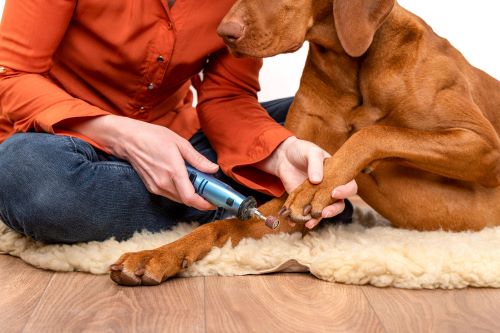How to Help Your Dog Not Hate Nail Trims

Keeping a dog’s nails trimmed is an important part of their overall health and wellness. Unfortunately, your dog may try to convince you otherwise. Though most dogs naturally dislike nail trimmings, it is necessary to prevent scratches to humans, other animals, and property alike. More importantly, long nails can affect the dog’s gait, leading to issues with skeletal health, paw health, and the overall physical fitness of the animal.
The good news is that trimming dog nails does not have to be a bad experience for anyone if done correctly! Your dog can learn to be calm during a trimming at home or the vet’s office with patience and proper training.
The Value of Healthy Nails
Like humans, maintaining clean and healthy nails prevents illness and promotes hygiene, but what if a dog’s nails are left to grow out? Failure to regularly trim a dog’s nails can lead to more serious issues than accidentally scratching furniture and people.
Skipping Trimmings Hurts Your Dog
Research completed by the American Kennel Club suggests that dogs face discomfort when their nails grow too long. So, while nail trimming can be an anxious experience, letting their nails grow longer than needed can be even worse for them.
A dog’s nail consists of tissues surrounded by a hard and protective shell. Beneath the hard shell is the quick, which is a tissue surrounded by nerves and blood supply. The quick can grow longer as the dog’s nail grows, making it more difficult and possibly painful during the next nail trimming session. Therefore, veterinarians recommend routine nail trimmings to keep the quick from growing too long.
Chronically Long Nails Can Make Your Dog Less Active
Additionally, when nails are long, a dog’s foot must adapt to how it touches the floor and distributes its body weight. Even if the dog can adapt to longer nails, it is easier to lose traction while running or making sudden stops. Too much time with long nails can lead to foot deformities and potential injuries to the tendons that support the foot’s mobility.
When a dog’s paw health begins to affect their ability to walk or enjoy exercise, it can affect their lifestyle. They can become less active, and they may experience pain during regular activities like walking. So, while a dog can adapt to longer nails, in the long run, it will cause potentially irreversible damage and more pain.
Why Nail Trimmings (Sometimes) Hurt
Nail trimmings shouldn’t actually hurt, although they can be uncomfortable. The pressure placed upon the nail and the individual toes can make some dogs, especially the more dramatic ones, feel as if they are being messed with in an unpleasant way.
Trimming nails too closely can, however, cause some pain. Since the center of a dog’s nail is full of tissue and nerve endings, when scissors accidentally cut the nail too short and expose the quick, it hurts your dog. The pain comes from exposing the sensitive area.
Sometimes, it can be difficult to see where the quick is, especially if the nail is dark in color. For the most part, when a dog has a light-colored nail, the quick is easier to avoid since it is visible.
Veterinarians recommend always having styptic powder handy if you cut your own dog’s nails. Even though bleeding nails are rarely life-threatening, if there is an accidental clip of the quick, the styptic powder can stop the bleeding when applied to the affected area. If not, the dog’s nail can bleed for over five minutes, and it risks exposure to infection. In the worst case, if there is an infection, it is recommend to bring your dog in to your veterinarian to be evaluated.
Trimming Dog Nails
Of course, as dog owners, the last thing we want to do is hurt our pets. However, research from Washington State University suggests that with time and patience, many dogs will eventually get used to the process and relax.
Use the Right Tools
Multiple tools can trim a dog’s nails, including standard scissors, guillotine scissors, and grinders. Many veterinarians use guillotine scissors to perform nail-trimming services by tilting the scissors to cut at a forty-five-degree angle with the farther end at the top of the nail.
Next is the grinder. Grinders are a great solution when trimming your dog’s nails, as they allow you to work slowly and from different sides while observing your pet’s reaction. In addition, the grinder is an excellent solution for nervous dogs, as it does not require the entire nail to be cut at once. As a result, many professional groomers have adopted grinders to perform their services.
Lastly, when it is time to cut the dew nail, you can use a standard scissor-shaped nail clipper while moving the dew nail away from the rest of the dog’s leg. Moving the nail away from the leg will allow the skin to be pulled back and grant better nail visibility.
When trimming a dog’s nails, you do not want to cut their nails too short. If their nails are clipped too short, there is a chance that you can clip into the quick, causing your dog pain and possible bleeding. In addition, hitting the quick can instill anxiety in your pet, so trying to avoid hitting it as much as possible should be the priority while completing this task. It is often better to err on the side of leaving the nail longer if you have had issues in the past with clipping into the quick.
How to Calm Your Dog to Trim Their Nails
Here are a few tricks and tips on how to calm your dog down to trim nails:
- Start when they are babies. There are many tips online to introduce your pup to a stress-free nail-cutting experience. You can find a sample training schedule here.
- Give peanut butter or a treat. Preparing a plate or flat surface with a good spoonful of peanut butter is a great treat — and distraction — for your dog while clipping its nails.
- Try a grinder instead. A grinder is a tool that gently and slowly grinds the nail down, reducing the margin of error. It smooths out sharp edges easier than a clipper and can be done in a small section at once.
Trimming dog nails does not have to be a daunting task and can be completed at home. However, clipping a dog’s nails requires the right tools, training, and patience. In addition, as the pet owner, you must constantly look for discomfort in your dog and work in multiple sessions if they are skittish.
While nail trimming can be simple, not all dog owners are comfortable doing it themselves. Greenlin Pet Resorts offers nail trimming services through our dog bathing and spa services. Additionally, we offer dog training camp sessions to help your pup learn the ropes of being a good boy or girl.
Leave Your Dog Nail Trimming Needs to Greenlin Pet Resorts
Keeping your dog’s nails trimmed regularly is part of their healthcare routine. Ready to set up an appointment? Contact us online, or visit one of our six locations in the Harrisburg area near you. Our staff will be happy to help you and your furry friend keep their nails looking great year-round!
